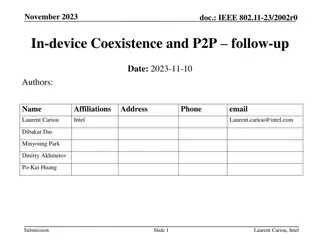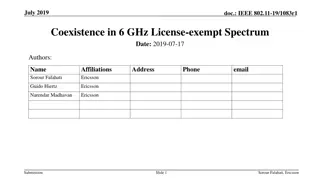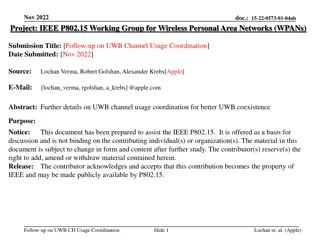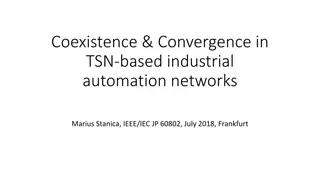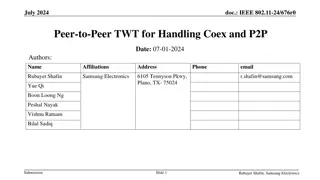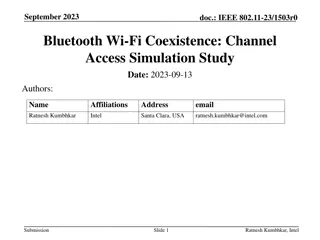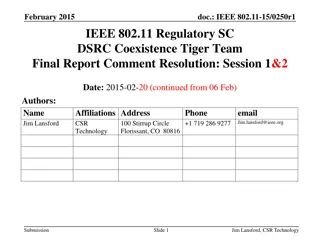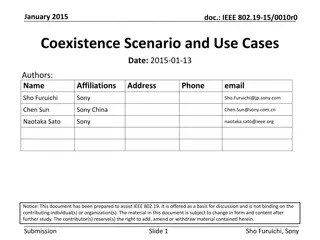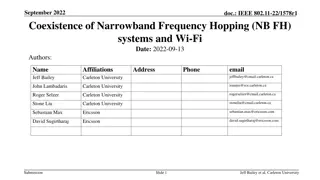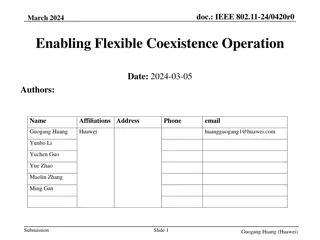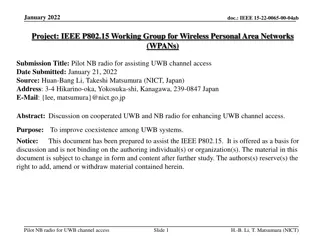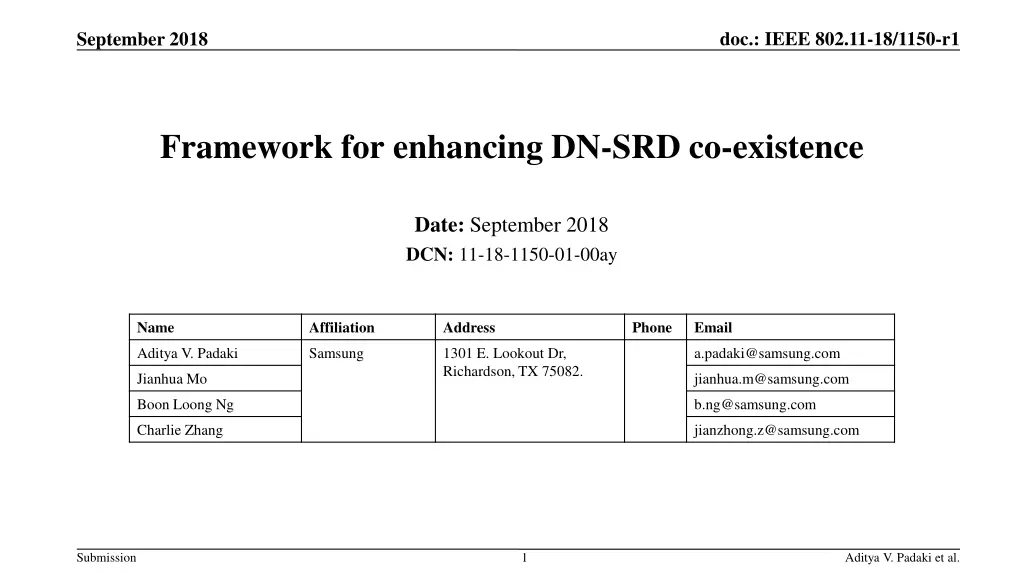
Enhancing DN-SRD Co-existence Framework September 2018 Overview
Explore the September 2018 framework for enhancing DN-SRD co-existence in IEEE 802.11-18/1150-r1 document. Discover the trade-offs, mechanisms, and considerations for managing co-existence, emphasizing the importance of protecting both DN and SRDs' interests while offering deployment flexibility. Gain insights into the transmit power/EIRP considerations, minimum inter-DN distance to avoid blockage, and EIRP observations for meeting target SNR and inter-DN distance. Dive into charts and guidelines provided for further analysis and discussions.
Download Presentation

Please find below an Image/Link to download the presentation.
The content on the website is provided AS IS for your information and personal use only. It may not be sold, licensed, or shared on other websites without obtaining consent from the author. If you encounter any issues during the download, it is possible that the publisher has removed the file from their server.
You are allowed to download the files provided on this website for personal or commercial use, subject to the condition that they are used lawfully. All files are the property of their respective owners.
The content on the website is provided AS IS for your information and personal use only. It may not be sold, licensed, or shared on other websites without obtaining consent from the author.
E N D
Presentation Transcript
doc.: IEEE 802.11-18/1150-r1 September 2018 Framework for enhancing DN-SRD co-existence Date: September 2018 DCN: 11-18-1150-01-00ay Name Affiliation Address Phone Email Aditya V. Padaki Samsung 1301 E. Lookout Dr, Richardson, TX 75082. a.padaki@samsung.com Jianhua Mo jianhua.m@samsung.com Boon Loong Ng b.ng@samsung.com Charlie Zhang jianzhong.z@samsung.com Submission 1 Aditya V. Padaki et al.
doc.: IEEE 802.11-18/1150-r1 September 2018 Overview Trade offs between Inter-DN distance, DN link parameters, DN link performance, and co-existence Example mechanism for managing co-existence Certain aspects for further consideration Submission 2 Aditya V. Padaki et al.
doc.: IEEE 802.11-18/1150-r1 September 2018 Co-existence framework DN-SRD co-existence framework should o protect the interests of both DN and SRDs o offer flexibility in design and deployment without rigid requirements o desirably be forward compatible given that DN infrastructure could well be a long term deployment We provide some charts that can be used for further analysis in upcoming discussions and deployment guidelines NOTE: In this presentation, for convenience o DN is used to refer to DMG or EDMG STAs that are employing the TDD protocol o SRD is used to refer other DMG and EDMG STAs Submission 3 Aditya V. Padaki et al.
doc.: IEEE 802.11-18/1150-r1 September 2018 Transmit Power/EIRP considerations Recap: Dual DN blockage is when both the DNs exceed the CCA threshold Rx Power > 68 dBm Rx Power > 68 dBm Submission 4 Aditya V. Padaki et al.
doc.: IEEE 802.11-18/1150-r1 September 2018 Min Inter DN Distance to avoid Dual Blockage Path loss model: ?????= 32.4 + 21log10?3? + 20log10?? Submission 5 Aditya V. Padaki et al.
doc.: IEEE 802.11-18/1150-r1 September 2018 EIRP to meet a target SNR and required inter DN distance to avoid dual DN blockage Observation for deployment guidelines: Higher DN Tx/Rx Gain helps in meeting the MCS/SNR target while ensuring Co-EX. Submission 6 Aditya V. Padaki et al.
doc.: IEEE 802.11-18/1150-r1 September 2018 Tx/Rx Gain vs Inter-DN Distance Plots show Tx/Rx Gain required to achieve the target SNR for a given Tx EIRP Higher Tx/Rx Gain required to avoid Dual DN Blockage and close DN links with target SNR Depends on Target SNR/MCS Depends on EIRP o o For a given Inter-DN Distance, if target SNR/MCS is set to avoid dual DN blockage This can limit the DN performance o o Even when SRDs are absent, DNs target SNR will be limited Submission 7 Aditya V. Padaki et al.
doc.: IEEE 802.11-18/1150-r1 September 2018 Enabling Co-Existence If for example, DN knows that there are no SRDs blocked, then it can optimize its transmissions further o If SRDs are blocked, then it can take some actions to enhance co-existence Currently, no mechanism for DN to ascertain if SRDs are blocked o DN being oblivious to this info can limit their performance and DN-SRD co-EX We present an example mechanism through which SRD can indicate DN that it is being blocked Submission 8 Aditya V. Padaki et al.
doc.: IEEE 802.11-18/1150-r1 September 2018 Example Mechanism: DTI Interval for SRD detection Proposed frame structure Beacon interval = 1024ms SP SP SP DN-SRD Co-EX DN-SRD Co-EX BTI BTI (with TDD channel access) (with TDD channel access) (with TDD channel access) SRD knows if there is a TDD-SP slot assigned from the ESE If SRD is unable to access the channel for a time Tmax then SRD will transmit a preamble o Since perfect sync between SRD and DN is not possible, DN will try coarse alignment o It will transmit the preamble soon after BTI frame Design itself is robust for complete misalignment as discussed further Preamble time length << DN-SRD Co-EX period Submission 9 Aditya V. Padaki et al.
doc.: IEEE 802.11-18/1150-r1 September 2018 Preamble Detection at DN Example: Consider preamble length 64 bits (less than half of control frame preamble length) and 144 bits (control frame preamble length) What preamble SNR is required at DN for matched filter detection? ? ?0 ??= ? ??? ,where ? is energy of the signal (proportional to preamble length) Submission 10 Aditya V. Padaki et al.
doc.: IEEE 802.11-18/1150-r1 September 2018 Received Preamble SNR CDF at DN For a false alarm rate of 0.01%, the CDF of receive SNR is as shown o Even with 23 dBm Tx EIRP of SRD, preamble (of 64 bits) is detected 75% of the time SRD had random location, directivity w.r.t DN Shows DN can successfully detect the presence of SRD DN Height=6m Inter DN Distance=200m Grid: x [1,200]; y [ 5,5] , z [0,6] Submission 11 Aditya V. Padaki et al.
doc.: IEEE 802.11-18/1150-r1 September 2018 Conditions for SRD to Report Blockage (for further study) The conditions under which SRD reports that it is being blocked are important issues for further study/discussion Examples conditions in concept include: o Pre-Condition: SRD ascertains DN operation in the vicinity o SRD unable to access channel even after ? consecutive channel access trials o Repeated failures to receive ACK or CTS Repeated has to be defined precisely How frequently will SRD report (send the preamble or report in ESE)? o Option 1: Once SRD reports, waiting period will get reset Example: ? consecutive channel access trials Report ? consecutive channel access trials o Option 2: Once SRD reports, waiting period reduces Example: ? consecutive channel access trials Report ?/? consecutive channel access trials Submission 12 Aditya V. Padaki et al.
doc.: IEEE 802.11-18/1150-r1 September 2018 Example DN Actions (for further study) Example (optional) DN actions upon receiving reports from SRD o Change DN TDD-SP duty cycling period o Reduce target SNR (or target MCS)/transmit power o Pause for one TDD-SP (to allow SRD to establish a link) Example scenarios if and when DN should take action Preamble time length << DN-SRD Co-Ex period o DN to take action only if multiple preambles are detected in one DN-SRD Co-Ex period o Alternatively, DN to monitor consecutive DN-SRD periods and only if multiple preambles are detected in consecutive DN-SRD Co-EX periods, DN takes some action Submission 13 Aditya V. Padaki et al.
doc.: IEEE 802.11-18/1150-r1 September 2018 Straw Poll Should there be a mechanism within 802.11ay draft for managing co- existence between DMG/EDMG STAs employing TDD-SP with other DMG/EDMG STAs (not employing TDD protocol)? Submission 14 Aditya V. Padaki et al.


